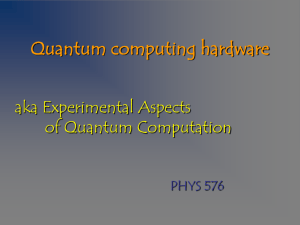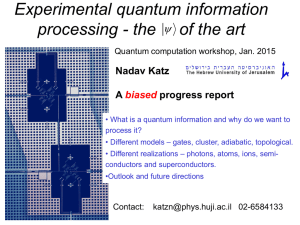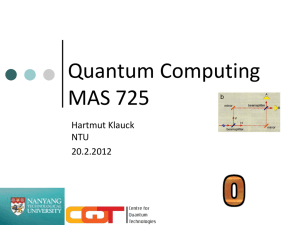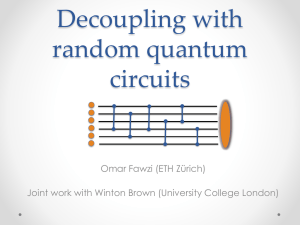P R A M A N A
advertisement
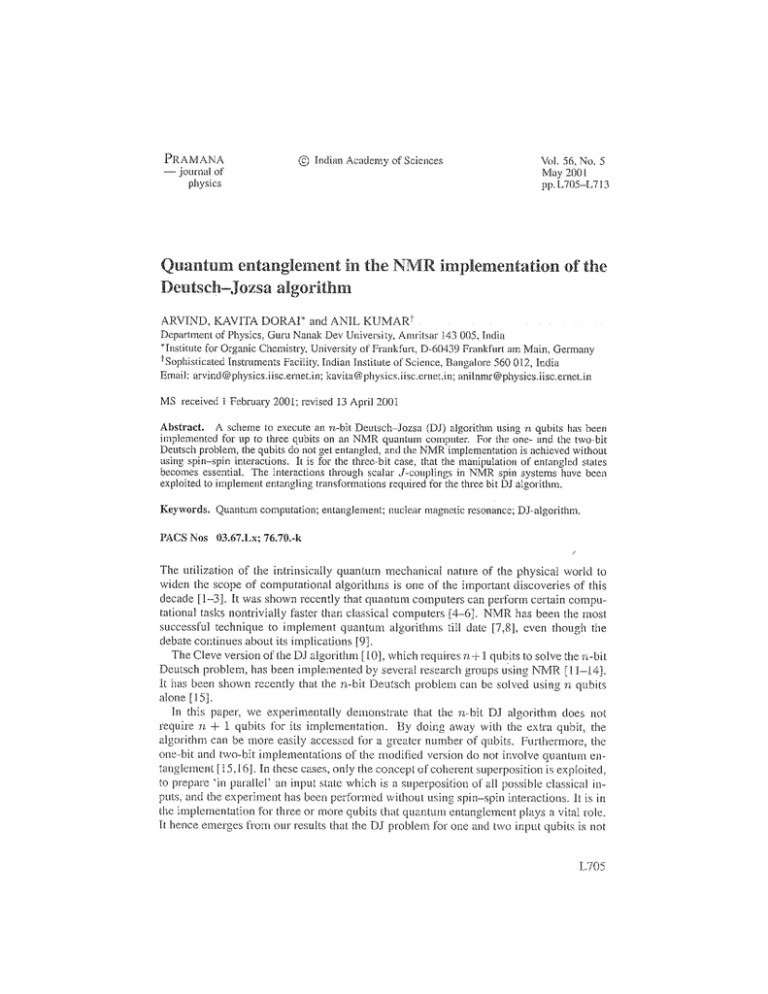
PRAMANA
- - journal of
physics
@ Indiau Academy of Sciences
Vol. 56, No. 5
May 200 l
pp. L705-L713
Quantum entanglement in the NMR implementation of the
Deutsch-,Jozsa algorithm
ARVIND, KAVITA DORAI* and ANIL KUMARII
Department of Physics, Guru Nanak Dev Universffy, Amritsar 143 005, India
*Institute for Organic Chemistry, University of Frankfurt, D-60439 Frankfurt am Main, Germany
iSophisticated Instruments Facility, Indian Institute of Science, Bangalore 560 012, India
Email: arvind@physics.iisc.ernet.in; kavita@physics.iisc,ernet.in; m~ilnmr@physics,iisc.ernet.in
MS received 1 Februaw 2001; revised 13 April 200t
Abstract. A scheme to execute an ~z-bit Deutsch-Jozsa (DJ) algorithm using 'v, qubits has been
implemented for up to three qubits on an NMR quantum computea For the one- and the two bit
Deutsch problem, the qabits do not get entangled, and the NMR implementation is achieved without
using spin-spin interactions. It is for the three-bit case, that the manipulation of entangled states
becomes essential. The interactions through scalar J-conplings in NMR spin systems have been
exploited to implement entangling transformations required for the three bit DJ algorithm.
Keywords, Quantum computation; entanglement; nuclear magnetic resonance; DJ~algorithm.
PACS Nos 03,67,Lx; 76.70.-k
The utilization of the intrinsically quantum mechanical nature of the physicai world to
widen the scope of computational algorithms is one of the important discoveries of this
decade [1--3]. It was shown recently that quantum computers can perform certain computational tasks nontrivially faster than classical computers f4-6~. NMR has been the most
successful technique to implement quantum algorithms till date [7,8], even though the
debate continues about its implications [9I.
The Cleve version of the DJ algoritlm~ [I 0], which requires r>51 qubits to solve the ~z-bit
Deutsch problem, has been implemented by several research groups using N M R [1 l-L4].
It taas been shown recently that the ~z-bit Deutsch problem can be solved using ~z qubits
alone [151.
In tt~is paper, we experimentally demonstrate that the ~>bit DJ algorithm does no{
require r~, + 1 qubits for its implementation. By doing away with the extra qubit, the
algorithm can be more easily accessed fur a greater number of qubits. Furthermore, the
one-bit and two-bit implementations of the modified version do not involve quantum entanglemen~ [i5,/6]. In these cases, only the concept of coherent superposition is exploited,
to prepare 'in parallel' an input state which is a superposition of all possible classical inputs, and the experimet~t has been performed without using spin-spin interactions. It is in
the implementation for three or more qubits that quantum entangIement plays a vitaI role.
It hence emerges from our results that the DJ problem for nile ~.lnd two input qubits is not
L705
ArvbM, Kavila Dorai and Alti! K u m a r
in essence a quantum problem. The non-trivial quantmn ['eatures in the algorithm show
up only fi~ the implementation for three or more qubits. The NMR impleme~ltation of the
modified DJ algorithm for one anti two qubits uses selective pulses that achieve rotations
in the subspaces of individual spins. The non-trivial phase shifts essential for the three~
bit problem have been implemented ~tsing composite z-pulses. A judicious combin,'.ttion
of selective r~ pulses and Dee evolution intervals (under the interaction Hamiltonian), has
been employed to eorlstlnct the required emangling transformations.
Consider an r>bit binary string :c; a functio~ f can be defined on this ~>bit domain
space to a 1-bit range sp~ce, with the restriction that either the outpttt is the same for all
inputs (the function is 'constant') or die outpvlt is 0 for half the inputs and 1 for the other
half {the function is 'balanced'). All ttle 2"* possible input strings are valid inputs for
the function (f(:c) = {0, 1}). In quantum computation, these 7>bit logical strings are in
one-to-one correspondence with the eigenstates of r>qubits, and one can hence label the
Iogical string :c by the eigenstate ]a:). Classically, for an r~.-bit domain space, one needs to
compute the function at least T z-~ + t times in order to determine whether it is constant
or balanced. The DJ algorithm achieves this on a quantum computer using only a single
function call [4,10].
The usual implementation of the DJ algorithm for 'r~ bits requires ra + 1. qubits, the
fanction f being encoded through an f~dependent unitary t,a,2sformatiou
(1)
where | denotes addition modulo 2. The implemeutation of the unitary transformation U/,
aIong with the Hadamard transformation, then suffices to distinguish the function as constant or balanced [4,I0]. A Hadamard transfo,madon on one qubit mixes the eigenstates
maximally,
7(Io) +
; H
[1>
= ~{--1
.~2
1
--1
'
(2)
The Hadamard transformation for n,-qubits is the tensor product of the one~qubit trallsfoi'marion (,rIa = -,rz | ]'Z | f2r | ' ' ' @ H), its action on the r>qubit eigenstates being
2 ~; _ ]
=
1
Z (1) |
X;
Iv},
(3)
F=O
where xj and :t;j are the j~h entries of the n-bit strings :~; and ~,,.
A modified scheme can be designed co solve the r>bit Deutsch problem, using r~ qubits
aIone [15]. Here, for every function f a unitary transformation is constructed, such thai its
action on the eigenstates of r>qubits is
t:c),>bi,; ..~s~ (_l)/(,)la;},~_bit.
(4)
It is instrnctive to explore tile relationship between eqs (1) and (4) and to see how exactly
we are able to get rid of the extra qubit for the function cal{ required in the okier scheme.
The original motivation behind including the extra qubit for the function calt in eq. (1) was
to construct a reversible(unitary) way of implementing otherwise irreversible function f.
L706
Pramatta - d. Phys., \tol. 56, No. 5, May 20{11
Io>,~-q~b~,
ConsU
BaI.
!__
El
Ri
INPUT
OUTPUT
Figure 1, The block diagram for the modified DJ algorithm.
However, it turns out that we can unitarily implement f without this extra qubit. The way
the flmction is being implemented in eq. (4) is through phase shifts which is a purely
quantum mechanical concept and has no classicaI analogue. On the other band, eq, (1) has
a classical motivation and it indeed reduces to a classical implementation if applied to,just
tile eigenstates of tile qubits involved. This brings out tile interesting f'act that one shoulcl
not ahvays use classical ways of implementing logic even on eigenstates, and it might
be useful to directly implement quantum schemes without botheri~lg about corresponding
classical analogues,
Consider ~z qubits, all in the state ]0); a Hadamard transformation 5/~ converts this state
to a linear superposition of all 2 '~ eigenstates with equal amplitudes and no phase differences. The unitary transformation Uf (defined in eq. (4)) acting on ttlis state, introduces
an f-dependent phase factor in each eigenstate in the superposk]on. At this juncture, all
information about f is encoded in the quantum state of the 'n, qubits, A Hadamard transformation H ~z is once again applied in order to extract the function's constant or balanced
nature:
1
2 '~ - 1
1
:~--0
2 ~ --t
H '~,
:e=0
1_2
x--O
y--O
The final expression for the output state in cq. (5) has an amplitude I for the state 10),>bi~:
for a constant function and an amplimde 0 for a balanced function.
The categorization of the function as constant or balanced through a single function call
using rF, qubits, is shown pictorially in figure 1.
The number of functions For the n-bk Deutsch problem is A'C'~\r/.e + 2 (where N = T").
The experimental impIementation of the modified DJ aIgorithm for r~, bits requires the realizatinn of the unitary transformation corresponding to each ol: these functions, alongwith
tile rl,-bit Hadamard transformation, on a physical system. We now proceed towards tile
NMR implementation of the modified DJ algorithm for One, two al?d three qubits, where
the number of functions are 4, 8, and 72 respectively.
The pseudo~Hadamard transformation i 17] (practically equ iwdent to the Hadamard op~
erator described in eq. (2)) achieved by a (90~ pulse on a spin, has been utilized it/our
Pramana -J, Ph.ys., V~L 56, No, 5, May 2(101
L707
Am, ind, Kavita Dorai and Ani! Kumar
Balanced
9.s
g r(l'bit')
"'8
9.0
%8
7.0
[ppm]
Figure 2. The modified DJ algorithm for one qubit imp]emented on 5-nitro-2-fulaldehyde, the proton resonating a~.9.2 ppm being chosen as the computation qubit.
experiments. For the case of two and three qubits, the same has been achieved by a (90~
pulse apptied non-selectively on alI the spins.
The ~,-bit unitary transforrnations Uf corresponding to (he functions f, are diagonal in
the eigenbasis and find a natural description in terms of the single-spin operators,
,,,,=(10);
0 ]
=
0
0)
'
(6)
where j labels the qubit involved. The action of Uf on an eigenstate (as described in eq.
(4)), has been used to calculate the explicit matrix lbrms of [7]', for every function f,
The operator representations of the four unitary transformations for the one-bk modified
DJ algorithm are
U} lbi~) = I (1)
g~ 1-bi~) _ _].(1)
g~ :l"djit')
O'!])
(const.),
(col]st.),
(bal.),
U~I1-bil0 :
(bal.).
-
-
- o ! 1)
(7)
A pseudo-Hadamard operation achieved by a (90~')v pulse is applied on a thermal initial
state, in order to create a coherent superposidon prior m applying the desired unitary transformations Uf. The constant functions correspond to a 'domothing' operation, while the
balanced functions are achieved by a rotation by the angle 7r about the z-axis of the spin,
up to a global phase Factor. Tllese z-rotations have been implemented using composite-z
pulses, whereby a rotation by an arbitrary angle (-; about the z-axis, can be decomposed as
a set of rotations about the :c and :q axes [18]:
(8)
Global phase changes are not detectable in NMR and are hence ignored. The spectrum
reflects the constant or bahmced nature o1' the l'tu]ctiotl implemented (figure 2). After die
L708
Pramana -.L Phys'., V,al. 56, No. 5, May 2~)1}]
Q~ta~tutn entat~gleme~t
~4
VFBalanced I
- W Us~2si~
Balanced
a_
~ U~=ui'~
~Constan~ ~ _ ,
9.s
~.o
U~ ~~'~I
[ppn'lJ.
Figure 3, The modified DJ ,'tlgo,:ithm fo, two qubits, implemented on 5-uitro-2-furaidehyde with the two qubits resonating at 6.47 ppm and 6.29 ppm respectively.
hnplementation of a balanced function, the qubit is in a state out-of-phase with the rest of
the spectrum, The modified DJ algorithm for one qubit demonstrates the power inherent in
even a single bit of qum~tum information.
All the 8 unitary transformatio~s corresponding to the functions for the two-qubit case
are given in terms of I(J) and o-~J) as
UI2 bi~.) _
U~e~biq _
f(t) @ 1(2)
o@) | [(2)
(const.),
(bat.),
= z(:'t c,~ o! ~1
!hal.),
U~I2-bit) = a~ z) @ o! 2)
(bal.),
~;:~b~;
(9)
All these operators are direct products of single spin operators. They are thus incapable
of generating entm~gled states and can be implemented by operations on h'~(Iividual spins.
A pseudo-Hadamard transformation was per[ormed on all the spins (initially in thermal
equilibrium) prior to the execution of the desired U) transformations. The two constant
functions correspond to the 'do-nottling' operation, experimentally. The NMR implemen~
taffon of the balanced functions U-~2~'m and U,~''t'~ involves rotations by ~r abou~ the z-axis
in the single-spin subspaces of spins 1 and 2 respectively, and have been achieved using
composite-z pulses (eq. (8)). The U[[~'~'~'> trans[:ormation too, does not require the scalar
J spin interaction and is impiemented as successive 7r rotations about the ,~-axes of spins
1 and 2 respectively. The balanced functions a,e distinguished by one (or both) the spins
being out-ol-phase with the rest or the NMR spectrum (figure 3). Only half the total number of functions have been shown in the one and two-qubit cases, as the others are merely
~egatives of these, and lead to the same spectral patterns (spectra not shown).
The three-qubit DJ algorithm affords the simplest example where quantum entanglement
plays a definitive role in the computation, We reiterate here, that a computation is truly
J~z'amat,a - j. l~hyx., Vol. $6, No. 5, NhD' 2(t01
]2709
Arvind, K a v i m D o t a l a#ld Anil K u m a r
qtl{tlltnnl ill character only when entanglement is present. The task ileie is co hnplement 72
unitary transformations, the explicit operator forms for 9 of which are
U}a-big = i ( 0 9 i(e) @/(s) (const.),
U~a-bit) = o-~1) @ I(2) @ I (s) (baL),
U:Ia-hit) = I (0 @ I (~) | or!s) (ba[.),
U-}3-biQ = 0_!1) @ ~!2) @ /.(3) (bal.),
Us(:~-bi~) = o-!:) @o'2 e) @o'! :~) (hal.),
(3 biD)
] _(1)
(f(2)
_/(3)
0~ 2)
I(3)
U(a-bil:)
1 _(2) @ (f(i) @ /(3) + crlt ) @ .[(3)
7
= ~-o.
@ f(1) @ (7! D) __ 0_{1) @ O.!3)) (b[ll,),
g(>b~e) = #cr~s)@ (i(n | i(~) + o_!1) | i(.))
U9 sdmit') _
i(cT(1) @ /T(2)@ f(%) + f(1) @ I(2) @ O.!<-0
-
~
O
_
O
+
o:o
@
(10)
(hal,).
The operators U~ah~*< ~.f~iI,bi,) Ca[] be decomposed as direct products of single-spin operators and are tshus non-entangling transformations. The operators U~~~*J-U~;~ L,~,:cannot be
decomposed as direct products of single-spin operators and are hence capable of generating entangled states from non-entangled ones. The operators U~aL'~~ U~ab~'~, and O~:~b~,~
are entangling i~ different two-spin subspaces and can be factored as direct products of a
single-spin operator and a two-particle entangling transformation. They can thus generate
states in which two qubffs are entangled, with the third qubit remaining non-entangled with
eitl~er of Clem. On tile other hand, 41e traasformatioi~ Ui~ t,~odoes not allow any such sin>
pEfications, It is maximally entangEng and leads to states that are three-qubk entangled.
These g functions are thus divided into three categories namely, non-entangling, two-qubit
entangling, and maximally (three-qubit) entangling. The remaining kmctions are similar
in form, and can be classed into one or the other of ttlese categories,
The result of experimentally applying the non-entangling transformations U{'~-~< U~a.,,~,
after a pseudo~Haclamard transformation on a thermal equilibrium state, is shown in figtire 4, The constant :function U{s-L< is the unit operator, and corresponds to the 'no pulse'
or the 'do-noflling' operation. The balanced functions U~~~'~ and U~a e>~ocorrespond to a
ro~adon by the angle rc about the z-axis of the first and the third spins respectively, without perturbing the other spins. This has been achieved by a spin-selective [Tr]s pulse in
each case, using composite z-pulses (eq. (8)). The spectrum is categorized by the spin in
question being out-of-phase with the rest of the spectrum. The transformation U}~:''''~ has
been implemented by two spinoseIeetive [scl: pulses applied consecutively on the lirst and
the second spins respectively, and leads to a spectrum wi[l~ both these splns being out-ol>
phase with tile thircl. The non-entangling balanced function U~:*L'~<~>has been implemented
by successive spimse{ecdve [~rlz pulses on all the three spins.
The two-qubit entangling transformation [r~:.~-~,~,J,is achieved by the pulse sequence
'
L7 [0
g)
" 9 c'
J ramalu~ - ] .
Phj,s.~ VoJ. 56, No. 5, fVho' 200i
~lJ~_~
4,.5
4.4
Balanced
U~(~'~''')
Balanced
Ug "*"
4.3
4.2
4.1
4.0
~'.9
.3.8~"~"-'w'-"'"'r-~3.7
[~'Orl'~]
Figure 4. The relhaed D.I algorithm for three qubits, imlpleme~ted on 2,3-clibromopropianic acid. The functions shown are all non-entangling in nature.
where "~2s = 1/J):.,, and 1, 2 and 3 are qubit l~bels. The operators U~:'~"> and U~a~''') eol)'espond to cyclic permutations of the qubits. The spin-selective ~ pulses in the middle of the
free evolution period "r:?3relbcus ~he chemicaI shift evolutiom The pulse sequence (applied
after a pseudo-Hadamard transformation on all three qubits in a thermal initial state) results in a density matrix with the product operator :form _.[1 + 2}'~ [2 + 2]~[i~, leading to a
spectrum with the muldplet of the first qubit i~averted, and an aadphase doublet of doublet
pattern lbr the other two qubits (figure 5). The three-qubit entangling function U~j~':') is
implemented by the pulse sequence
leadh.?g to an alltiphase spectral pattern fox"all three qubi~s, corresponding ~o die product ope,ators 2li~./-~-k 27~'.{~]+4!~ I~.[~ (figure 5). The spectra in figure 5 suffer f,om phase disto,dons arising from the inaccurate refocusing of the d~emical shifts during tile 7-periods, and
.]-evoh,tion during long spin-selective composite-z puises ([Tr]i ~ I~/2]/i:[~]i,[?r/2]~_ ~. =
42 msec).
This implementation of the DJ algorithm does not require the initial preparation of the
sp]ns in a pseudo-pure state, since the d~ert?)al equilibrium state serves equafly welt as a
good ioitiat stale. The observable spectral result is the same in both cases, though begin~
ning witl~ a pseudo-pure s~ate creates some (undetcctable) .muItiple-quatmm~ cohereaces.
Further, .it is interesting to note that due application of an e~ltangling transformatioo to an
unenlangled state does not always lead to an entangled state. In particular, R~r the three-bit
DJ algorithm implemented on dlermal initial states, the final output state (carryi~lg in.foro
mafion about the ]:unction's constant or balanced nature), is une~ltangled, even though some
of tile unitary transformations required are entangling in nature.
Pz'al~lau~z - d. ])h3,s. ~ Vol. $6, N~,). 5, May 2001
]~7 1 I
Arvind, Kavita Dotal and AMI KmTtar
q>
BaLanced
L~
Balanced
,~,],~
4
~
Balanced
r'----m- r'--~'~ " ~ - - ~ ' ~
4.5
zl.4 4,3
..... i " ~ " - ' - ' ~ - E~ ' ~ r ~ - ' 7 - - ~
4.2. 4 . i
4.0
3.9
3.:g 3 . 7
U~~b;')
S(~.-biL)
U ~ . 3 bl,}
[ppl'a~_]
Figure 5. Entangling balanced functions implemented on the three-qubit system of
2,3-dibromopropionic acid.
The final pseudo-Hadamard {tans:formation to extract the construct or balanced natnre
of the function (figure [) is cancelled by the (90) ~ read-out pulse usually used in NMR
experiments, and the computation essentialIy culminates in the application of the desired
Uf function after the first pseudo-Hadamard transformation.
A modification to the usual DJ algorithm enabled an ~>bit implementation using 'r~
qnbits. The reqtfired unitary transformations were tailored to eliminate the need for the
extra qubit, and the modified DJ algorithm was tested experimentaily for one, two and
three qubits. While the one and two qubit cases use non-entangling unitary transform>
tions, it was noted that for three (or more) qubits, multi~particle entangling transformations
are essential. The NMR implementation of such entangling transformations requires the
presence and manipulation of spin-spin interactions [19].
Aek~mwledgemem
The use of the AMX~400 spectrometer at SIE lISc, Bangalore, funded by DST, New Delhi,
is gratefully acknowledged.
Refere~ees
[lJ D P DiVincenzo, Science 270, 255 (1995)
[2] S Lloyd, Sci. Am. 273, 44 (1995)
[3] [ L Chuang, R Lal~amme, P W Shot and W H Zurek, Science 270, 1633 (1995)
[4] D Deutsch and R Jozsa, Proc. R. Soc. Lottdoll A439, 553 (1992)
[15] P W Shot, SIAM.L Comput, 26, I484 (/997)
[611 L K Grover, Phys. Rev. Lett. 79,325 (1997)
[7] D G Cory, A F Fahmy and T F Havel Proc. Notl. Acod. Sci. USA 94, 1634 ([997)
[8] N Gershenfeld and l L Chuang, Science 275, 350 (1997)
L7 ! 2
Pramam~- Z Phys'., Vol. 56, No. 5, May 2001
QuaJ~tu~?~ e t ~ l a n g l e m e ~
[9] S L Braunstein et al, Phys. Rel~. Letr. 83, 1054 (1999)
[10t R Cleve, A Ekert, C Macchiavello and M Mosca, Proc. R. Sac. Lo~ad(m A454, 339 (1998)
1-11.] I L Chuang, L M K Vandersypen, X Zhou, D W Leung and S Lloyd, Nature 393, 143 (1998)
[121 J A Jones and M Mosca, .l. Chem. Phys. 109, 1648 (1998)
{13) N Linden, H Bmjat and R Freeman, Chem. Phys. Letl. 296, 61 (t998)
[14] Kavita Dotal, Arvind and Anil Kumar, Phys. Rev. A61, 042306/1~7 (2000)
[15l D Collins, K W Kim and W C Holton, Phys. Re~., A58, R1633 (1998)
[161 A Eker~ and P L Knight, Am. J. Phys. 63,415 (1995)
[17] JA Jones, R H Hansen and M Mosca, Y. Mag~z. Reso~L 135, 353 (1998)
[18] R R Ernst, O Bodenhausen and A Wokaun, Principles (~/'~tuclear magl~etic resoJ~ance in one
a~zd t~t~o dimelzsions (Oxford University Press, Oxford, 1994)
[19] Arvind, Kavita Dorai and Anil Kumar, LANL e-print quant-ph/9909067
l'ramaHa - .], Pb.),s,, Vot. 56, N~,~. 5, May 21]{,~1
L7.13

